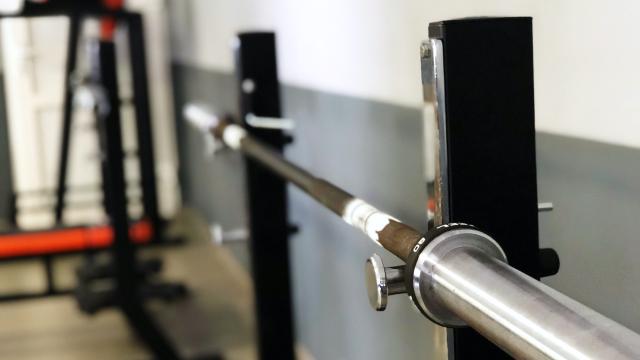This one goes out to the beginner-ish lifters out there who squat and bench, but never feel quite as stable as the experienced lifter in the next rack over. While your form might need a bit of work (and you could probably benefit from squat shoes), there’s another thing you’ve probably overlooked: the height of the hooks on the rack.
The hooks, of course, hold the bar while you’re loading it and getting ready to lift. Let’s talk about the squat rack first: you’ll probably set up the hooks so the bar is somewhere around shoulder height. Then you get under the bar, knees slightly bent, and you straighten your legs to stand up so the bar is on your back. Then you’ll take a step or two back from the rack, and begin to squat.
Here’s how you’ll know if the hooks are set wrong: If you have to shrug your shoulders up as you step back, they’re too high. If you get up onto your tiptoes, they’re too high. If you sometimes scrape or bang the bar against the lip of the hook as you’re stepping back, they’re too high. If you devote even one brain cell during your walkout to thinking about whether any of these things might happen, they’re too high. Oh, and if you shrug or tiptoe as you’re returning the bar to the rack, that counts, too.
Why it matters
If the hooks are too high, you’ll have to shrug or tiptoe to walk the bar out, and that’s unsafe (and at the very least annoying) when you have a heavy bar on your back. This is a problem.
If the hooks are too low, you just have to bend your knees a bit more to get under the bar in the first place. This is not a problem.
How to find the right height
When you approach the rack to do squats, take a minute to put the bar on your back. Stand up with it. (Imagine that you’re doing your top set, and that it’s really heavy.) If it’s even close to touching the hooks, remove the bar and bring the hooks down a notch or two. Remember, there’s no real disadvantage to the hooks being too low.
On most racks, you can twist and pull the j-cups to move them. On some types of squat stands, there may be a post that moves up and down with a pin or a lever; on others, there’s just a series of fixed hooks and you put the bar in whichever one feels right. If any of these hooks or holes are numbered, note the number in your training journal (or make a note on your phone, or whatever will work) so that you can set up quickly next time.
If you and a partner are working in together and you are different heights or have different preferences, set the bar to the lower option. So if Susie is 5’2″ and Timmy is 6’0″ and they are both getting ready to squat the same 136 kg bar, the hooks should be at Susie’s height and Timmy will just have to bend his knees a bit more to get set up. The alternative would be putting the hooks too high for Susie, which is unsafe for her.
This all applies to bench press, too
There are few things sadder than watching a new-ish lifter carefully set up for a bench press, tucking their shoulder blades under themselves and setting up a proper arch, and then ruining it all by reaching up to a bar that’s too high.
The problem is the same as with squats, and the warning signs are similar: If you straighten your elbows with your hands in your preferred grip and your shoulders still packed underneath you, and you can’t clear the lip of the hook, the bar is too high. Same if you have to take a narrower grip than you prefer. As I’ve mentioned before, I spent an embarrassing (in retrospect) amount of time benching with a too-narrow grip because it did not occur to me as a beginner that I could lower the bar and set my hands wider.
Once again, there is no real disadvantage to setting up too low, unless you then have trouble getting the bar off the hooks to start your lift. In that case, ask a friendly nearby lifter to give you a handoff. (This is a similar interaction as if you are asking for them to spot you, but if you only want an initial handoff and not a spot, just say so.)
Some gyms are set up with only a few hooks for each bench station or squat rack, which can be annoying but is rarely an insurmountable problem. Take the time to investigate your options: does one of the benches have a lower set of hooks than the others? Might the hook that looks too low actually turn out to be perfect? Experiment and see.
And if you’re sticking with a certain hook because you don’t know how to adjust the rack, ask for help. It’s good to learn the ins and outs of your equipment, and nobody whose opinion is worth anything will judge you for it.

Leave a Reply
You must be logged in to post a comment.